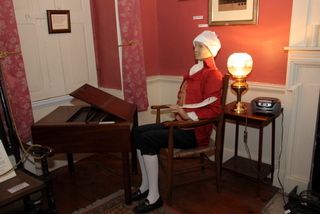In order to write this post, I will need to put on my thinking cap. We’re all familiar with this phrase as a figure of speech, but in the nineteenth century, there was indeed a strong connection between thoughtful writing, and the wearing of headgear.
The hat conventionally marked for nineteenth-century culture the border between outside and inside, public and private. As a result, certain sorts of headgear could indicate the continual interiority of the writer. One might recall that Louisa May Alcott’s character Jo in Little Women (1868/9), when seized by the desire to write, would don a special writing cap:
Every few weeks [Jo] would shut herself up in her room, put on her scribbling suit, and ‘fall into a vortex,’ as she expressed it, writing away at her novel with all her heart and soul, for till that was finished she could find no peace. Her ‘scribbling suit’ consisted of a black woollen pinafore on which she could wipe her pen at will, and a cap of the same material, adorned with a cheerful red bow, into which she bundled her hair when the decks were cleared for action. This cap was a beacon to the inquiring eyes of her family, who during these periods kept their distance, merely popping in their heads semi-occasionally to ask, with interest, “Does genius burn, Jo?” They did not always venture even to ask this question, but took an observation of the cap, and judged accordingly. If this expressive article of dress was drawn low upon the forehead, it was a sign that hard work was going on, in exciting moments it was pushed rakishly askew, and when despair seized the author it was plucked wholly off, and cast upon the floor. At such times the intruder silently withdrew, and not until the red bow was seen gaily erect upon the gifted brow, did anyone dare address Jo.
Jo’s writing-cap is not extant, but this sort of detachable item of clothing specifically associated with authorial creativity has often survived because celebrated. As illustrated by Frank T. Merill in the 1896 edition of Little Women, Jo’s writing-cap is much like a night-cap, made of soft fabric to keep the head warm and (in the case of women) to confine the hair, or (in the case of men) to keep the head warm in the absence of hair. This last was especially true in the eighteenth century, when gentlemen’s heads were typically shaved to manage headlice, and wigs were popped on over. In fact, writers would often have retired to their closets, where they would have cast off both hat and wig and put on what was called a night-cap.
Indeed, the nightcap and equivalent headgear was something of a conventional marker for the scholar or poet, and was used to denote this occupation in eighteenth-century writing. Oliver Goldsmith’s poem ‘Description of an Author’s Bedchamber’ in his novel The Citizen of the World (1760/1) describes the author’s squalid living-arrangements, noting that ‘A night-cap deck’d his brows instead of bay’. In more heroic mode, the night-cap connoted poetic genius in William Hoare’s 1739 portrait of Alexander Pope; and French author Germaine de Staël was portrayed by Gérard in 1810 in a turbanesque variant.
One nineteenth-century author constantly pictured wearing a nightcap is William Cowper. Cowper’s nightcap has become somewhat of a trade-mark. George Romney famously portrayed Cowper in an embroidered and goffered white cotton version in a remarkable painting of 1792; Charles Dickens would describe Cowper represented with his nightcap in a charade in The Old Curiosity Shop (1841); Robert Browning evoked Cowper’s entire cultural importance through an imagined display of his nightcap in his poem Turf and Towers of 1873; and G. K. Chesterton notes that in a pageant devoted to eighteenth-century writers, Cowper could be rendered instantly recognisable by his nightcap. For Cowper, the nightcap indicated a chosen withdrawal from public life and the glitter of the world, as described in the poem The Task (1785), and the adoption instead of an informal circle of intimates and a life of country domesticity. Romney’s image was often remarked upon as also implying a certain wildness of nature.
Nowadays, within the Cowper and Newton Museum in Olney, the nightcap makes a number of appearances: the famous cap itself (dated to 1788) is displayed in a glass case along with Cowper’s hair (admittedly less shiny than Keats’, see last post for details) and other personal effects. Meanwhile Cowper’s dummy sits at the desk in the parlour, twirling a quill in its hand, wearing the replica nightcap.
Cowper’s nightcap is effective as it presents the writer’s body as that of the writer known to the reader through famous texts and an associated iconography. It is the recognisability of the hat, its ability to reiterate iconography, that gives it force. Linked so intrinsically to Cowper’s identity as an author, the nightcap renders the dummy instantly recognisable as a representation of the writer, regardless of any physical inaccuracies. Given that Cowper’s dummy is modelled from a cast-off female shop mannequin, this is really just as well.
Also on Cowper see https://www.open.ac.uk/blogs/literarytourist/?p=219 and https://www.open.ac.uk/blogs/literarytourist/?p=206

